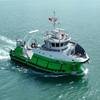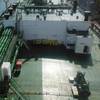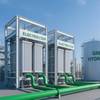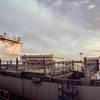Under a plan spelled out in SB 428, by state Senator Don Perata (D-Alameda), a new panel will be created to oversee the development of a proposed network of high-speed ferries serving the entire San Francisco Bay Area. The new panel will be called the San Francisco Bay Area Water Transit Authority.
Governor Gray Davis signed the bill last year, giving the Transit Authority the go-ahead to prepare a detailed plan for expanding ferry services in the San Francisco Bay Area for the legislature's approval.
The authority's 11-member board will be made up of local elected officials, environmentalists, business leaders and transportation experts; four appointed by the Governor and two each appointed by the Senate Committee on Rules and the Assembly Committee on Rules. Three members will be members of a community advisory committee to be convened not more than six months from the date of the first meeting of the board.
The Authority will hold hearings in all of the nine counties that will benefit under the proposal. The plan calls for a system of 120 high-speed ferries, achieving speeds up to 40 knots, serving up to 40 ports in the Bay Area. The Metropolitan Transportation Commission (MTC) will review the proposal and a final plan will be submitted to the state Legislature.
"The Bay Area is choking on traffic congestion and air pollution, and exploring the option of putting more ferries on the bay offers the promise of some safe, clean relief," Perata said. "The new water transit authority is the surest and quickest way toward increasing the number of ferries on the San Francisco Bay. The Governor's support means we're one step closer to having a world-class ferry system for a world-class region."
Environmental Concerns
The bill was not passed without its share of controversy. Bluewater Network released a study claiming the ferry system will cause significant additional air pollution and may lead to increased smog and water pollution in the Bay Area.
Dr. Russell Long, executive director of Bluewater Network said, " Our study shows these ferries will be ten times more polluting per passenger than an automobile, and 23 times more polluting than transit buses. The Air Resources Board needs to take a close look at this ferry bill or years of hard-won pollution decreases will probably be reversed."
As a result of the study, Long says, the bill was modified to require further environmental reviews, by state environmental agencies, specifically of the air emission impacts of the ferry system.
A feasibility analysis and proposal for the use of new technologies and alternative fuels in marine engines, to minimize air emission and water pollution impacts from the system operations, will be conducted in cooperation with the Bay Area Air Quality Management District, the Regional Water Quality Control Board, and the Bay Conservation and Development Commission.
Additionally, a systemwide regional programmatic environmental impact report and study of the plan, consistent with the requirements of the California Environmental Quality Act and the National Environmental Policy Act of 1969 will be conducted. The report will include an independent evaluation conducted by the Bay Area Air Quality Management District to assess the air quality impacts of the complete water transit system in comparison to transporting the same number of people over the same distance by motor vehicles and other modes of transportation.
Plan Particulars
Aided by the MTC, the Authority shall investigate possible terminal locations throughout the San Francisco Bay area, and will identify all necessary and appropriate steps required to coordinate the water transit system with other elements of the San Francisco Bay area transportation network. There are strict prohibitions against negatively impacting existing services.
Ultimately, the San Francisco Bay Area Water Transit Implementation and Operations Plan shall include all of the following:
· A detailed description of the high-speed water transit system, including, but not limited to, all routes to be operated and terminals to be served during the 10-year period following funding of the authority. The description may include phasing of the routes to be served and terminals to be constructed.
· An adopted demand model based upon ridership surveys conducted throughout the region and an updated demand model developed by the MTC.
· A water transit demand analysis, based upon the demand model, of the demand forecast and cost-effectiveness for the water transit system as a whole and for each corridor to be served.
· Architectural design criteria and standards for terminals and landside facilities to meet the performance objectives and operational criteria. The architectural design criteria and standards for terminals shall be developed in cooperation with the community advisory committee and in consultation with local jurisdictions that are prospective hosts of terminals for the water transit system.
· An intermodal plan to connect water transit services with other modes of transportation and public transit, including, but not limited to, cooperative arrangements with existing public transit services and new intermodal services. The intermodal plan shall be developed in cooperation with the community advisory committee, the technical advisory committee, and existing ground transportation agencies.
· A feasibility analysis and proposal for the use of new technologies and alternative fuels in marine engines and ground transportation intermodal services, to the extent feasible, to minimize air emission and water pollution impacts from the system operations. The analysis shall be conducted in cooperation with the Bay Area Air Quality Management District, the Regional Water Quality Control Board, and the Bay Conservation and Development Commission.
· A plan for monitoring air emissions and water impacts that is mutually agreed upon by the authority and the entities listed above.
· Design specifications for vessels, consistent with the architectural design criteria and standards for the terminals and landside facilities and the feasibility analysis to minimize air emission impacts.
· A plan for acquiring the requisite vessels, including, but not limited to, a proposed request for proposals, that incorporates the design specifications and seeks to support shipbuilding and fleet maintenance within the region to the extent possible.
· A plan for ensuring safety of vessel operations traveling on the San Francisco Bay. The plan shall be developed in cooperation with the California Maritime Academy and the USCG.
· A systemwide regional programmatic environmental impact report and study of the plan, consistent with the requirements of the California Environmental Quality Act and the National Environmental Policy Act of 1969. The report shall include an independent evaluation conducted by the Bay Area Air Quality Management District to assess the air quality impacts of the complete water transit system, as set forth in the San Francisco Bay Area Water Transit Implementation and Operations Plan, in comparison to transporting the same number of people over the same distance by motor vehicles and other modes of transportation.
· An overall funding and financing plan based upon the detailed description of the water transit system and demand analysis, including, but not limited to, acquisition and construction phasing.
· A projection of capital and cash-flow requirements, including, but not limited to, costs for vessels and associated maintenance facilities, terminals and associated land use costs, and costs for feeder vehicles and associated maintenance facilities.
· A projection of operating costs and revenues, including, but not limited to, projected patronage, fare structure, and fare revenues for water transit and feeder services.
· A proposal for ongoing operating financial support.
· An analysis of the cost-effectiveness of the water transit system in comparison to other options for mobility and disaster relief and recovery. The analysis shall be prepared in cooperation with the MTC.
Perata said the Authority will begin work in mid-2000 after funding is secured in next year's budget.
Sponsored Content
Safer Starts Here: Build Ships, Protect Crews

July 2025
 Read the Magazine
Read the Magazine

 Read the Magazine
Read the Magazine
This issue sponsored by:

Deep Strike: Seabed Warfare Will Target More Than Cables and Pipelines
Subscribe for
Maritime Reporter E-News
Maritime Reporter E-News is the maritime industry's largest circulation and most authoritative ENews Service, delivered to your Email five times per week







